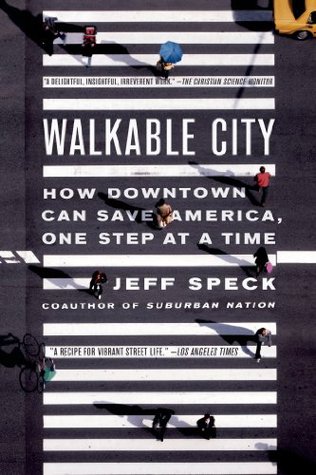More on this book
Community
Kindle Notes & Highlights
by
Jeff Speck
Read between
March 14 - April 20, 2022
city engineers—worshiping the twin gods of Smooth Traffic and Ample Parking—have turned our downtowns into places that are easy to get to but not worth arriving at.
The above anecdote is far from unusual in today’s landscape of disassociated professions and special interests that determine the shape of our communities. The modern world is full of experts who are paid to ignore criteria beyond their professions. The
“We are a destructive species, and if you love nature, stay away from it. The best means of protecting the environment is to live in the heart of a city.”
Traffic studies are typically performed by firms that do traffic engineering. This makes perfect sense—who else would do them? But guess who gets the big contract for the roadway expansion that the study deems necessary? As long as engineers are in charge of traffic studies, they will predict the need for engineering.
Most cities need congestion to keep driving in check, because driving costs drivers so much less than it costs society.
“Beyond a certain speed, motorized vehicles create remoteness which they alone can shrink. They create distances for all and shrink them for only a few.”45
Gehl and Krier are probably right that the most pleasant and livable cities are those like Amsterdam and Paris that were principally built before elevators. This outcome is, of course, more dependent on the fact that they were also built before cars, but the human scale of the buildings contributes as well.
have adopted this confusion as doctrine.■ To be fair, egotism and the desire for celebrity are only partly responsible for this orientation. It also comes from an insistence on intellectual honesty. Just as a building supposedly bears the obligation to be “of its time,” it must also be “of its author.” For the designer of a large structure to pretend to be many different designers is to falsify the historical record, especially since the modern myth of the genius architect insists that every designer’s personal style is as unique as his fingerprint.
Jacobs was fighting a dominant ethos that more green spaces make cities more healthy, when in truth their microcosmic appearance belies their macrocosmic impact. By separating useful things from each other, they can contribute to an automotive culture that exacerbates pollution.
Indeed, it was desire to somehow magically merge city with country that created the environmental, social, and economic disaster that is sprawl. Still, it is common to come across architecture-school proposals and design-competition entries that have us questing for “a new and unprecedented relationship between man and nature,”■ as if there is some undiscovered way to improve the city by diluting its best qualities. We know better. And we know that central among these qualities is the street life that is only possible in a truly urban environment, where there are more buildings than bushes.


